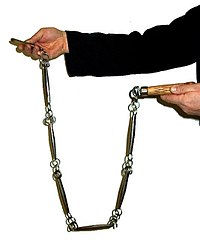Jiujiebian
| Jiujiebian | |
|---|---|

|
|
| Information | |
| Weapon type: | Percussion weapon, whip |
| Designations: | Nine-part whip, chain whip |
| Use: | weapon |
| Region of origin / author: |
China , martial artist |
| Distribution: | China |
| Overall length: | about 150 cm |
| Handle: | Wood, metal |
| Lists on the subject | |
The Jiujiebian ( Chinese 九節鞭 / 九节鞭 , Pinyin jiǔjiébiān - "nine-part whip"), also chain whip or chain whip , is used in various martial arts. In addition to the nine-limbed whip, there are also variants with fewer or more limbs, e.g. B. the Qijiebian ( 七 節 鞭 / 七 节 鞭 , qījiébiān ) with seven limbs.
description
It is most commonly used in Chinese martial arts , i.e. in modern and traditional Wushu . It consists of several metal rods, the ends of which are connected with rings and thus form a flexible chain. Usually there is a handle at one end of the chain and a small point at the other end, which is intended for slitting or piercing the fictional opponent. Often there is a cloth at or just below the tip, a second can be attached to the handle. When using the whip, these ensure a typical Wushu performance, both visually and due to the rapid whizzing that occurs when swinging in the air. But they also help stabilize the chain and give the martial artist better control over the weapon. The risk of injuring yourself during use is reduced and the position of the tip can be better localized with fast movements. In addition to the typical punching and twisting techniques, strangling and disarming can also be used. In addition, the range of the weapon can be shortened by wrapping the hand with chain links, which facilitates control. It is also typical to wrap the weapon around joints on the arms, trunk or legs and swing it back explosively from there. Often it is also wrapped around the neck, which significantly increases the risk of injury. A professional introduction is useful before training with the weapon, as it can unintentionally wrap around body parts and pinch off and break out of the flight path.
literature
- Jie Zhang, Richard Shapiro, Liu Bin's Zhuong Gong Bagua Zhang: South District Beijing's Strongly Rooted Style Foundation Practices . Blue Snake Books, 2008, ISBN 978-1-58394-218-5 .